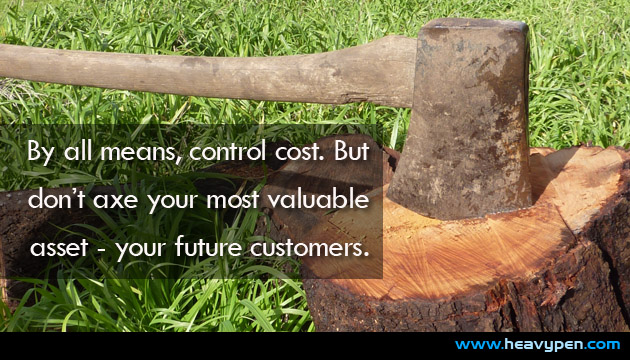
Marketing Budgets: Don’t cut your most valuable asset
Control your costs. Trim your budgets. However, before you cut your marketing program, consider Cost-of-Acquisition as a valuable asset, and act accordingly.
It’s not an overthink. Global organizations, major corporations, and even some small companies are trending over to the concept of treating all marketing (advertising, promotions, public relations) as asset-building investments. Gone is the old notion of thinking of customer outreach as purely an expense-based cost of doing business. The focus is shifting away from disposable engagement and more toward long-term relationships and retention. Acquisition of new customers is important, and now we weigh all activities as cumulative. This is how the cost of marketing has crossed over from the expense column and into asset building investment.
Sure. All businesses want to control cost. It’s a concern made more complicated when facing end-of-season downturns, cyclic pressure, or even recessionary stagnation. How you respond to these situations is also the great divider: where successful and unsuccessful marketers often part company.
When cash is down, cut budgets, right?
It is only natural to think that during any downturn we cut expenses where we can – from the workforce, from services and things that seem frivolous from the perspective of the bottom line. For many SMBs (small to medium-sized businesses), marketing often falls into that class; perhaps not “frivolous” per se, but definitely expendable. That’s where managers often make their gravest mistake.
There are categories where cuts are not noticeable at all: Tchotchke convention giveaways? Superfluous! Fresh flower bouquets on the receptionist’s table? Superfluous! How about content development, website maintenance, consistent press releases, search engine visibility, collateral materials, your sales staff? This is where I recommend caution. You may offset costing by delaying development of a new website, or tighten up your SEO strategy so that expenses are focused on specific outreach. That’s why I would start with a careful analysis of where you are today and trace to where you want to be in the future. Be like a surgeon and cut carefully to avoid harm.
Valuation is valuable.
It’s a tough balancing act, to be sure, if you don’t know where to look. I recommend that you begin with an estimate of the present value of your marketing program. Find the answer to these four questions:
- The value of each customer (per transaction)
- The value of your marketing outreach (per customer).
- The value of Customer Base
- The cost of reacquisition.
Value of Each Customer
The value of each customer is a necessary calculation that all entrepreneurs and managers should regularly do. For the value of each customer (per transaction), use a simple ‘sales basis’ by dividing the total number of completed transactions per year into the annual gross sales.
The Value of Marketing Outreach
The value of your marketing outreach might be a little trickier. This is an estimate for the cost of your marketing effort. I include website development, content creation, hosting charges, sales materials, advertising, public relations, et cetera – PLUS the cost of sales and support staff. Note that many companies exclude customer relationship management (CRM) from marketing because quality control is part of the manufacturing/design process, but CRM has a dual role in retention – so, I would include it.
The Value of the Customer Base
Finish off with a grand total of the two values (Each Customer plus Marketing Outreach). Divide the result by the number of completed transactions, and now you have a number to use for the Value of your Customer Base.
Consider that the ‘old school’ method is to calculate for gross margin (total sales revenue minus the cost of goods sold, divided by the total sales revenue). That calculation is valuable, but it only gives you a part of the picture. What we NEED is a total understanding of appreciation of investment in our business. When you treat marketing as purely expendable expense – (e.g., office supplies) you may end up disposing an important assessed value. Consider the work that investors perform when assessing the viability of a company; is not the value of the customer base part of the company’s overall value. Consider what happens when the value of acquisition is low (e.g., high transactions, low cost).
Need more convincing? Picture this. Many large corporations don’t merely spend into marketing; they invest into it. Therefore, doesn’t it make more sense to tally up the investment value with the return (gross sales) to find the total value of the asset (the customer)?
With a sound valuation of your customer base, you arrive at a clearer picture of the real value of your customers; not only regarding what they have purchased but what you have invested (in terms of time and money) to acquire them.
Why is this important?
For one thing, it takes many calculations to arrive at a full assessment. So why think of marketing from only one perspective? Gross margin only shows what you’ve managed to squeeze out of COGs without an appreciation for underlying built value of the customer base. That brings us to the fourth question – the cost of reacquisition of customers – which can be tricky.
There’s no ‘over the counter’ solution, no easy formula – and no complicated algorithm (although I’d love to try to find one) that can help us find an absolute value for the acquisition of something that was lost. You can’t merely pay a replacement cost as you would replace a computer or piece of furniture. Replacing customers takes time AND money – talent, timing, and luck. The loss of a customer base is compounded each day that customers are not buying, and each day you’re trying to get them back. Moreover, replacement cost increases AFTER the loss because you have to rebuild the brand promise, re-establish customer trust and re-establish the all-important positive attitudes and opinions that drew customers to you in the first place.0
Doesn’t it make better sense to support the investment in your customer and keep them instead?
Here’s another point – somewhere along the line we have to recognize that we can either underspend or overspend on marketing. The best tool is a good calculation of “real value” of the customer base that tracks over time as often as you would calculate gross margin. Take notice when the two calculations deviate too much one way or the other.
By all means, control cost. But don’t cut your most valuable asset – your future customers. At the end of the day, can you give up the convention pens and the cartoon buttons? Probably. My recommendation – make these calculations before you make your move.
About: Ray Wyman, Jr is a content creator, communications professional, and author with more than 30 years of experience. Visit LinkedIN or Raywyman.com for more information.


